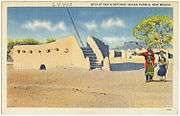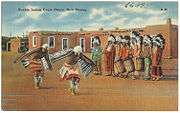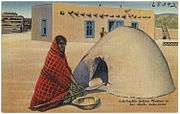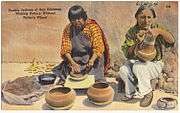Pueblo V Period
| Ancestral Puebloan Periods |
|---|
 |
|
Archaic–Early Basketmaker Era 7000 – 1500 BCE |
|
Early Basketmaker II Era 1500 BCE – 50 CE |
|
Late Basketmaker II Era 50 – 500 |
|
Basketmaker III Era 500 – 750 |
|
Pueblo I Period 750 – 900 |
|
Pueblo II Period 900 – 1150 |
|
Pueblo III Period 1150 – 1350 |
|
Pueblo IV Period 1350 – 1600 |
|
Pueblo V Period 1600 – present |
The Pueblo V Period (AD 1600 to present) is the final period of ancestral puebloan culture in the American Southwest, or Oasisamerica, and includes the contemporary Pueblo peoples. From the previous Pueblo IV Period, all 19 of the Rio Grande valley pueblos remain in the contemporary period. The only remaining pueblo in Texas is Ysleta del Sur Pueblo, and the only remaining pueblos in Arizona are maintained by the Hopi Tribe. The rest of the Pueblo IV pueblos were abandoned by the 19th century.
The Pueblo V Period (Pecos Classification) is similar to the "Regressive Pueblo Period."
History
Considerable change occurred during the Pueblo V Period due to Spanish colonization of the Americas beginning in the 16th century and the United States westward expansion of the 19th and 20th centuries. These influences resulted in:
- Population decline due to European diseases
- Efforts to secure traditional Pueblo lands by the Europeans and other Native American tribes
- Establishment of Indian reservations[1]
The Crow Canyon Archaeological Center notes, "Today, Pueblo people live in the modern world while maintaining their distinct culture and rich traditional heritage."[1]
Cultural groups and periods
The cultural groups of this period include:[2]
- Ancestral Puebloans - southern Utah, southern Colorado, northern Arizona and northern and central New Mexico.
- Hohokam - southern Arizona.
- Mogollon - southeastern Arizona, southern New Mexico and northern Mexico.
- Patayan - western Arizona, California, and Baja California.
Notable abandoned sites
The people from the following sites abandoned their pueblos and generally blended into Puebloans societies in the Rio Grande valley of New Mexico:
- Bailey Ruin - Arizona
- Bandelier - New Mexico
- Casa Grande - Arizona
- Mesa Grande - Arizona
- Pueblo Grande - Arizona
- Pecos - New Mexico, abandoned in the 19th century
- Puye Cliff Dwellings - New Mexico

During the Pueblo IV period, Four Corners pueblo settlements were abandoned (northern and central portion of the Anasazi region.)

Federally recognized Pueblos
There are 21 federally recognized Pueblos that are home to Pueblo people.[3][nb 1]
Gallery
-

North Pueblo, Taos Pueblo
-

Kiva at San Ildefonso Pueblo
-

Green Corn Dance at Tesuque Pueblo
-

Pueblo Eagle Dance
-

Puebloan woman at her adobe bake-oven
-

Puebloans of San Ildefonso making pottery
See also
- American Indian Wars in the Southwest
- Pueblo - modern and ancient pueblos
- Pueblo Revolt of 1680
- Puebloan peoples
Notes
- ↑ The two pueblos not identified in the Rio Grande valley map of the Pueblo IV Era are the Hopi Tribe of Arizona and the Ysleta del Sur Pueblo of Texas
References
- 1 2 Pueblo Indian History Crow Canyon Archaeological Center. Retrieved 10-14-2011.
- ↑ Gibbon, Guy E.; Ames, Kenneth M. (1998) Archaeology of Prehistoric Native America: An Encyclopedia. Routledge. pp. 14, 408. ISBN 0-8153-0725-X.
- ↑ "Indian Entities Recognized and Eligible To Receive Services From the United States Bureau of Indian Affairs; Notice" Federal Register 12 July 2002, Part IV, Department of Interior, Bureau of Indian Affairs
